M1888 Lee-Metfield bayonet

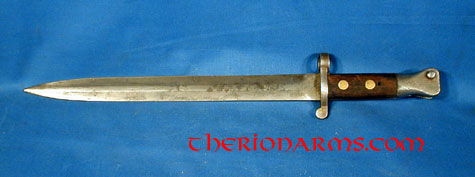

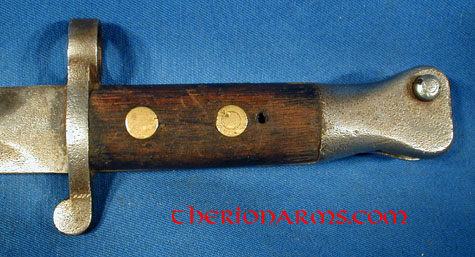
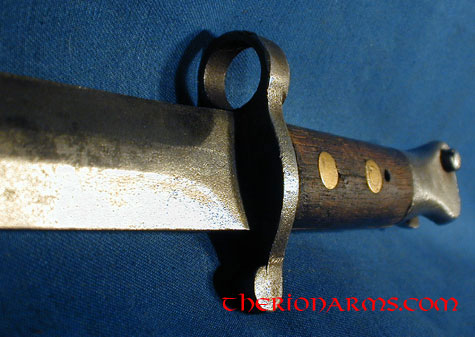
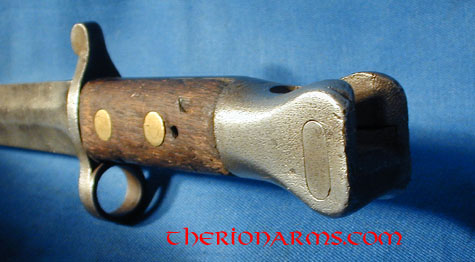
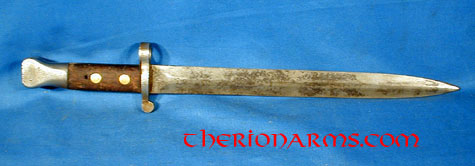

length: 16 1/2"
Bayonet for the M1888 British Lee-Metfield rifle. Mark II, second pattern.
"The Bayonet Pattern1888 produced for the Lee-Metford Rifle, comprises a
double edged blade of approximately 12" in length. This blade common to all
variants of this bayonet. The blade is not fullered but is of distinctive
shape in cross-section being almost an elongated diamond shape.
The grips are of wood and the first pattern of this bayonet had these grips
secured with three brass rivets. these comprised, one large rivet, and two
smaller rivets were situated side by side. An oiling hole was situated just
below this pair of smaller rivets.
Shortly after the introduction of this bayonet, a new version was issued in
which the grips were secured by only two brass rivets. The large rivet
remained unchanged, but the two small rivets were now replaced by a single
large rivet which was positioned below the oiling hole.
The next modification of this bayonet, the Mark 2 came with the introduction
of the Mark 1 Lee Enfield rifle. The bayonet is identical to the previous
example save for the relocation of the oiling hole in the grips. The
adoption of the new rifle meant that this was relocated to to the pommel,
this also resulted in the brass rivets through the grips being moved further
apart."
The Ballad of the Bayonet (P.T Ross, 1901)
Did I ever use the bay'nit, sir?
In the far off Transvaal War,
Where I fought for Queen and country, sir,
Against the wily Boer.
Aye, many a time and oft, sir,
I've bared the trusty blade,
And blessed the dear old Homeland, sir,
Where it was carefully made.
Chorus
Then here's to the British bay'nit
Made of Sheffield steel,
And here's to the men who bore it -
Stalwart men and leal.
You notice the dents on the edge, sir
At Bronkhurst Spruit they were done;
I was getting a door for a fire,
For out of wood we had run.
I was smiting hard at the door, sir,
Or rafter, I'm not sure which,
When I struck on an iron screw, sir,
And the bay'nit got this niche.
'Tis my mighty Excalibur, sir,
I've use it in joy and grief,
For digging up many a tater,
Or opening bully beef.
I have used it for breaking wire,
Making tents 'gainst rain and sun;
I have used it as a hoof-pick,
In a hundred ways and one.
Oh, how did the point get blunted, sir?
I was driving it home
As a picketing peg for my horse,
So that he should not roam.
I drove it in a little, sir,
And then in my haste, alas,
I stubbed the point on a rock, sir,
Some inches below the grass.
You ask if it e'er took a life, sir?
Aye, I mind the time full well;
I had spotted him by a farm, sir,
And went for him with a yell.
He tried to escape me hard, sir,
But I plunged it in his side,
And there by his own backyard, sir,
A healthy porker died.
But did I draw it in action?
You ask me roughly now.
Yes, we were taking a kopje,
The foe were on the brow.
We drew and fixed our bay'nits,
The sun shone on the steel:
Death to the sniping beggars
We were about to deal.
Then, sweating and a-puffing,
We scaled the rocky heights,
But when we reaches the top, sir,
The foe was out of sight.
Has it e'er drawn human blood?
Yes once, I grieve to say;
It was not in a battle,
Or any bloody fray;
'Twas just outside Pretoria,
The deed was never meant,
I slipped and fell on the point, sir,
'Twas quite by accident.
Chorus
Then here's to the British bay'nit
Made of Sheffield steel,
And here's to the men who bore it -
Stalwart men and leal.
And here's to the Millennium,
The time of peaceful peace,
When neighbours shall love each other,
And wicked wars shall cease.
From "A Yeoman's Letters," PT Ross, 1901
blade: 11 3/4"
blade width: 1 1/8"
grip: 4 1/2"
guard: 2 5/8"
weight: 1 lb
History from
A primer of British military bayonets: